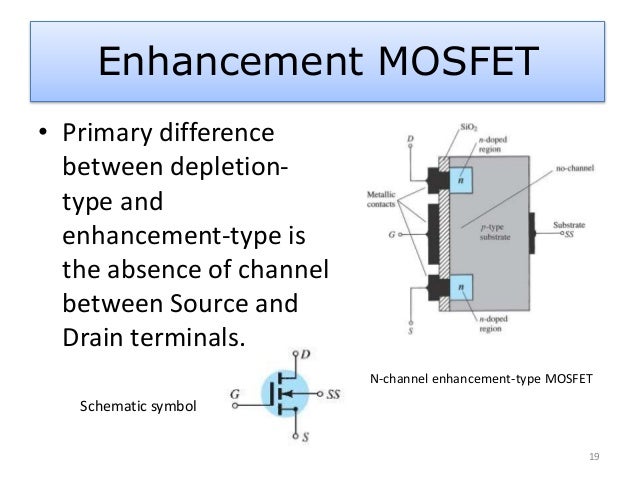Depletion Enhancement Mosfet
Difference between enhancement and depletion type mosfet
- Difference Between Depletion & Enhancement Mosfet
- Enhancement Mosfet Vs Depletion Mosfet
- Depletion And Enhancement Mosfet Symbol
- The symbols for enhancement and depletion MOSFETs show a difference in the second vertical line from the left, marked in red. For the enhancement MOSFET this line is discontinuous. This shows that the MOSFET is switched off with a V GS = 0 V. With a V GS = 0 V a depletion MOSFET can conduct current, and this is shown by the dashed line.
- A SIMPLE explanation of a Depletion Type MOSFET. Learn what a Depletion-type MOSFET is, how it works, and the difference between a depletion type MOSFET.
An enhancement-type MOSFET is so named an enhancement device, because as the voltage to the gate increases, the current increases more and more, until at maximum level. An enhancement-type MOSFET behaves very similar in action to a bipolar junction transistor. The other type of MOSFET, a depletion-type MOSFET, has the complete opposite behavior.
Depletion mode MOSFET is normally turned on at zero gate voltage. Such devices are used as load resistors.
MOSFETs with enhancement modes are the common switching elements in most MOSs. These devices are deactivated at zero gate voltage and can be switched on by powering the gate.
In field effect transistors (FET), exhaust mode and amplification mode are two major types of transistor, corresponding to whether the transistor is in the ON or OFF state at zero gate-source voltage.
Enhancement MOSFET
MOSFETs with enhancement modes can be switched on by powering the gate either higher than the source voltage for NMOS or lower than the source voltage for the PMOS.
In most circuits, this means that pulling a MOSFET gate voltage into the leakage boost mode becomes ON.

For N-type discharging devices, the threshold voltage could be about -3 V, so it could be stopped by dragging the 3 V negative gate (leakage by comparison is more positive than the NMOS source).
In PMOS, polarities are reversed.
The mode can be determined by the voltage threshold sign (gate voltage versus source voltage at the point where only a layer inversion is formed in the channel):
Difference Between Depletion & Enhancement Mosfet
- For a N-type FET, modulation devices have positive and depleted thresholds – modulated devices have negative thresholds;
- For a P-type FET, positive mode to improve negative mode, depletion.
Depletion MOSFET
Junction-effect junction transistors (JFET) are the depletion mode because the gate junction would transmit the bias if the gate was taken more than a bit from the source to the drain voltage.
Such devices are used in gallium-arsenide and germanium chips, where it is difficult to make an oxide isolator.
Figure describes the construction of MOSFET type of exhaustion. Also note the MOSFET circuit type N exhaust channel symbol.
Due to its construction, it offers very high entry strength (approximately 1010 to 1015). Significant current flows for VDS data at 0 volts VGS.
When the gate (ie, a capacitor plate) is made positive, the channel (i.e., the other capacitor plate) will have a positive charge induced therein.
This will lead to the depletion of the major bearers (ie electrons) and therefore to the reduction in conductivity.
Difference between enhancement and depletion type mosfet in tabular form
Enhancement Mosfet Vs Depletion Mosfet
| Sr.No. | Depletion MOSFET (D-MOSFET) | Enhancement MOSFET (E-MOSFET) |
| 1 | It is called a depletion MOSFET because of channel depletion. | It only works in enhancement mode and is therefore called Enhancement MOSFET. |
| 2 | It can be used as E-MOSFET. | It can not be used as a D-MOSFET. |
| 3 | If Vgs = 0 V, Ids flows due to Vds. | If Vgs = 0V, Ids = 0, although Vds is applied. |
| 4 | N-type semiconductors exist in the structure itself between source and drain. | There is no n-channel between source and drain. |
| 5 | Do not occur | When Vgs = Vt, the MOSFET is turned on. |

Depletion And Enhancement Mosfet Symbol
Now you know difference between enhancement and depletion mosfet.
